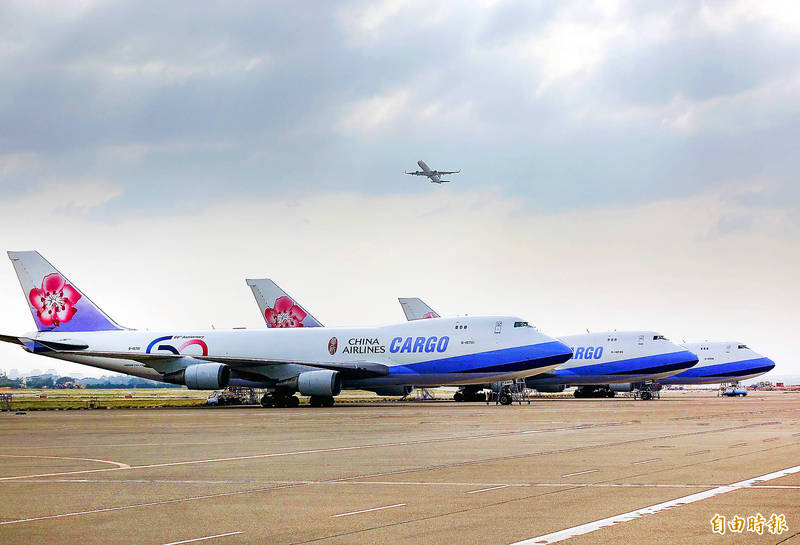《TAIPEI TIMES》 New rules to cut cargo hauls 10%: CAL

Cargo planes operated by China Airlines Ltd are parked at Taiwan Taoyuan International Airport on Friday. Photo: Chu Pei-hsiung, Taipei Times
LEFT OUT TO DRY? A freight forwarder manager said that the capacity issue is more worrying than a rate hike, as no airlines can offer flights to offset the reduced capacity
By Kao Shih-ching / Staff reporter
The stricter anti-COVID-19 measures that the Central Epidemic Command Center (CECC) has imposed on China Airlines Ltd (CAL, 中華航空) are predicted to reduce the airline’s cargo capacity by about 10 percent, the company said yesterday, rejecting market speculation of a 50 to 80 percent cut.
A CAL official told the Taipei Times that the center’s measures, dubbed the “Down to Zero 2.0” plan, had been misunderstood, as many thought that all 1,279 CAL pilots would immediately stop flying and be quarantined at government centers.
“That is not the case,” the official said by telephone.
The center would divide the pilots into two groups — low risk and high risk — and have all of them quarantined step by step so that the airline’s operations would not be significantly affected, the official said.
CAL pilots who are in a quarantine hotel or at a collective quarantine station would be in the low-risk group, and could fly after 14 days of isolation and testing negative for COVID-19, the official said.
The rest of the pilots, who would form the high-risk group, could continue to fly, but they would need to quarantine for 14 days. If they tested negative, they could be switched to the low-risk group.
However, pilots in the two groups would not fly together, the company said.
Once all of the pilots were in the low-risk group, the new measures could be dropped, but that is expected to take three months.
Over those three months, CAL would prioritize cargo operations over its passenger business, as Taiwan is a trade-oriented economy and many local companies rely on exports, the company said.
However, passenger operations would not halt, it added.
Even though the company only expects a 10 percent cut in its cargo capacity, the new measures would still affect the air cargo market, a freight forwarder manager said by telephone.
“It is uncertain by how much CAL’s air cargo rate can increase, as this week’s flights and freight rates have been set in the contracts. We are waiting for CAL to decide which flights will be canceled,” the manager said.
“We are worried more about the capacity issue than the rates, as there are no airlines that can offer additional flights to offset the reduction in CAL’s capacity. So it is certain that some clients will be affected,” he said.
Some products, such as panels, chips and other technology products, are not suitable for ocean transport, so it is a challenge to transfer the air cargo orders to surface shipping, he said.
Taiwan Semiconductor Manufacturing Company (台積電) and United Microelectronics Corp (聯電) said that their shipments are not likely to be significantly affected by CAL’s reduced cargo capacity.
Chip packaging and testing firm ASE Technology Holding Co (日月光投控) and passive components maker Yageo Corp (國巨) expressed similar views.
Additional reporting by CNA
新聞來源:TAIPEI TIMES














